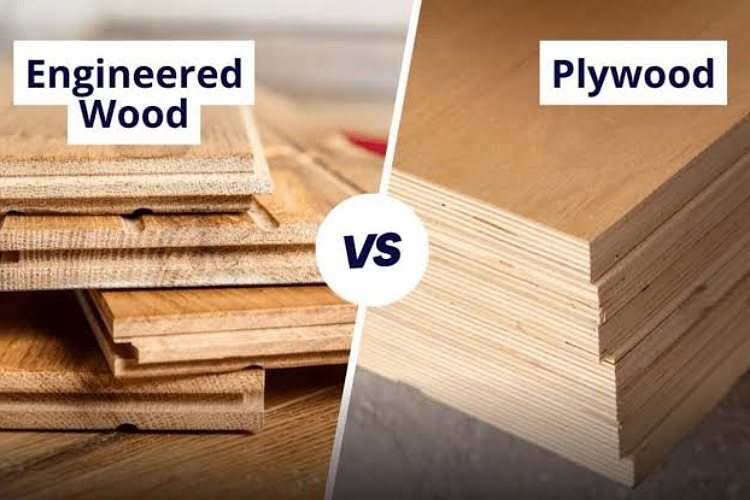Introduction
In the dynamic world of construction and interior design, selecting the foundational materials can significantly impact a project’s longevity, aesthetics, and overall cost. For decades, plywood has been a go-to choice, renowned for its strength and stability. However, the market has seen the rise of various “engineered wood” products, offering compelling alternatives with unique properties. Understanding the nuances of engineered wood vs plywood is no longer just for professionals; it’s essential for anyone aiming to make an informed decision for their home or commercial space. This guide will meticulously break down the characteristics, performance, and ideal applications of both, empowering you to select the perfect material for your specific needs, ensuring durable and beautiful results.
Defining the Contenders: Composition and Construction
To truly grasp the distinction in the engineered wood vs plywood debate, we must first understand their fundamental composition. Plywood is a classic engineered wood panel, created by glueing together multiple thin layers of wood veneer. A defining characteristic is its cross-grain construction: each successive layer is oriented perpendicular to the one below it. This unique layering technique is what gives plywood its remarkable strength, dimensional stability, and resistance to splitting along the grain, making it an incredibly robust material for various applications, from structural sheathing to furniture. The type of wood veneer, the number of plies, and the adhesive used all contribute to the final grade and properties of the plywood.
Engineered wood, as a broader category, encompasses various wood composite materials that are manufactured by binding wood fibres, particles, or strands together with adhesives under heat and pressure. This category includes materials like Medium-Density Fibreboard (MDF), High-Density Fibreboard (HDF), Particle Board, and HDHMR (High-Density High Moisture Resistant) board. Unlike plywood’s layered veneer structure, most engineered wood products have a homogeneous composition throughout their thickness. For instance, MDF consists of very fine wood fibres, resulting in a smooth, consistent surface, while particleboard uses larger wood chips. Each type of engineered wood is designed with specific properties to suit different applications, often offering a more uniform density and surface finish compared to traditional plywood.
The core difference in construction impacts everything from their strength to their workability. While plywood leverages the natural strength of wood grain in multiple directions, engineered wood composites achieve their properties through the rearrangement and binding of wood elements, often resulting in isotropic strength (equal strength in all directions) and a denser, more consistent core. This foundational understanding is key to discerning which material, in the engineered wood vs plywood context, is best suited for the demands of your project.
Performance Showdown: Durability, Strength, and Moisture Resistance
When evaluating engineered wood vs plywood for performance, several key metrics come into play, including durability, strength, and perhaps most critically, moisture resistance. Plywood generally boasts superior bending strength and impact resistance due to its cross-grain layering. It can withstand heavier loads and resist racking forces more effectively, making it a preferred choice for structural applications, subflooring, and heavy-duty furniture frames where integrity under stress is paramount. Higher grades of plywood, like Marine Grade or BWP (Boiling Water Proof), are specifically designed with waterproof adhesives to offer exceptional resistance to water and delamination, even under prolonged exposure.
Engineered wood products, while strong, typically have lower bending strength compared to equivalent thicknesses of plywood. However, their high density contributes to excellent screw-holding capacity, particularly for furniture where components are frequently assembled and disassembled. For moisture resistance, standard MDF or particleboard fares poorly against water, swelling significantly. But specialised engineered wood products like HDHMR board are specifically manufactured with advanced resins and higher compression to offer remarkable resistance to moisture and humidity, often outperforming even some grades of plywood in damp interior conditions, resisting swelling and warping.
Furthermore, termite and borer resistance is a crucial aspect of durability. Many quality plywood variants come pre-treated with anti-termite and anti-borer chemicals, offering a long-lasting defence against pests. Similarly, several engineered wood products are now available with integrated anti-termite and anti-fungal treatments during their manufacturing process. Therefore, when considering engineered wood vs plywood for long-term durability, it’s essential to check the specific treatment and grade, as both categories offer robust solutions against common wood-destroying organisms, ensuring your investment is protected from hidden damage over time.
Workability and Aesthetics: Shaping Your Vision
The practicalities of working with a material and its final aesthetic appeal are significant factors in project planning. Plywood is relatively easy to cut, nail, and screw, and its layered edges can be left exposed for a rustic look or seamlessly finished with edge banding. It offers a natural wood grain when veneered or stained, providing warmth and character. However, cutting plywood can sometimes result in splintering or tear-out, especially with less sharp tools or lower-grade veneers, requiring careful technique and potentially more finishing work to achieve perfectly smooth edges.
Engineered wood products, particularly MDF and HDHMR, excel in workability for specific tasks. Their homogeneous composition allows for incredibly smooth and precise cuts, intricate routing, and detailed carving without splintering or chipping. This makes them ideal for decorative panels, cabinet doors with profiled edges, or any application requiring a crisp, clean finish. Their consistent density also provides superior screw holding, making them highly suitable for modular furniture where components are assembled with fasteners. However, engineered wood often requires more secure fastening near edges to prevent crumbling under stress.
Aesthetically, both materials can be transformed to suit any design vision. Plywood takes well to paints, laminates, and natural wood veneers, offering a range from contemporary to traditional looks. Engineered wood, especially HDHMR, provides an exceptionally smooth surface that is perfect for high-gloss paints, membrane finishes, and thin laminates, as its uniform density eliminates surface imperfections. This makes the choice in engineered wood vs plywood often dependent on the desired final appearance and the complexity of the fabrication work involved, with engineered wood often simplifying the path to a flawless, uniform finish.
Cost, Applications, and Your Project’s Needs
The financial aspect is a major determinant in material selection. Generally, basic grades of plywood (like MR grade) can be more cost-effective than some engineered wood products like HDHMR. However, specialised plywood grades (like BWP or Marine) can be comparable to, or even more expensive than, high-quality engineered wood options. The overall cost calculation should also include labour savings from easier workability and less finishing, as well as the longevity of the material in its intended environment. A material that costs more upfront but lasts longer or requires less labour can be more economical in the long run.
Plywood remains the go-to for applications requiring high structural integrity and bending strength, such as roofing, subflooring, wall sheathing, and heavy-duty furniture frames. Its dimensional stability across varying loads makes it indispensable for many construction applications. Different grades of plywood cater to interior, exterior, and marine environments, offering a versatile range of solutions for diverse project needs, from basic carpentry to robust outdoor builds.
Engineered wood products, particularly HDHMR, are increasingly becoming the preferred choice for modern modular furniture, kitchen cabinets, bathroom vanities, wardrobes, and interior panelling where moisture resistance, a smooth finish, and intricate routing are key. Their uniform density and excellent finish potential make them ideal for contemporary designs. The decision on engineered wood vs plywood ultimately hinges on a detailed evaluation of the project’s specific requirements: the level of moisture exposure, the structural demands, the desired aesthetic finish, and the overall budget. By weighing these factors carefully, you can make the most informed choice for durable and successful results.
Conclusion
Navigating the choices between engineered wood vs plywood is a pivotal step in creating long-lasting and aesthetically pleasing interiors. Both materials bring unique strengths to the table: plywood offers unparalleled structural integrity and traditional versatility, while modern engineered wood products, like HDHMR, excel in moisture resistance, screw-holding, and achieving seamless finishes. There is no single “best” material; rather, the optimal choice depends entirely on the specific demands of your project, its environment, structural needs, design aspirations, and budget. By understanding the distinct properties and best applications of each, you are well-equipped to make a strategic decision that ensures the durability, beauty, and success of every endeavour.

